Abstract
The collapse of overlying rocks caused by the instability of residual coal pillars during lower coal seam mining significantly impacts its safety. This paper focuses on the gentle dipping coal seam group and utilizes the discrete element method (DEM) as the basis to comprehensively consider multiple factors through orthogonal experiments. In so doing it reveals the influence mechanisms of various factors on mining at a close distance under a residual coal pillar. Firstly, the process of lower coal seam mining under residual coal pillars in gently-dipping coal seams was simulated and analyzed based on a case study at the Baoping coal mine. Comparing the evolution characteristics of coal–rock fractures, stress changes, and displacement changes during the mining process reveals the mechanism of the joint instability of the lower coal seam, interlayer rock, coal pillars, and overlying strata under the disturbed conditions of lower panel mining. Secondly, an orthogonal simulation experiment was established using the width of the coal pillar and the thickness of the lower coal seam as variables. By comparing the development process of cracks, stress distribution, and rock displacement under different conditions, the research results indicate that the width of coal pillars has an impact on the maximum amount of coal pillar subsidence, while the thickness of the underlying coal seam has an impact on the time of subsidence, when hd ≥ 4.2 m (hj/hd ≤ 4) and w ≤ 14 m (w/hm ≤ 2), a large-scale collapse of the overlying strata of the coal pillar occurs.
1. Introduction
In recent years, the problem of mining under situations of close-distance coal seams has gradually attracted attention. The mining of multiple coal seams gives the overlying strata different migration characteristics than single coal seam mining, and the law of mine pressure is more complicated than that of a single coal seam [1,2,3,4,5,6]. Gao et al. [7] have analyzed the distribution of dynamic ground pressures, geological characteristics, and stress fields in coal mining sites. Based on this analysis, they established a detailed classification system for rock burst mechanisms and provided guidance for controlling rock bursts in similar mining conditions. Yang et al. [8] used a mechanical model to reveal the influence law of multi-coal seam mining and the dynamic breaking mechanism of overburden and calculated the strata movement parameters and influence range of multi-coal seam mining.
A large number of studies have shown that the residual coal pillars in multi-coal seam mining may have gradual or abrupt instability under the influence of overlying rock stress and mining disturbance, which will further induce the displacement failure of the overlying strata and lead to accidents in the lower panel [9]. Therefore, many scholars have begun to study the coal pillar and rock strata as a whole. The deformation and failure characteristics, energy change characteristics, acoustic emission characteristics, and fracture evolution characteristics of these coal–rock assemblages have been analyzed in detail using theoretical analysis, physical simulation experiments, and numerical simulation [10,11,12,13,14], and the influence of surrounding rock lithology, loading conditions, rock dip angle, and other factors have been studied [15,16,17,18]. Gao et al. [19] analyzed the stress distribution characteristics with or without the overlying coal pillar by numerical simulation and established a functional model between the peak stress of the surrounding rock and the concentrated stress of the coal pillar and the distance from the panel to the coal pillar and its buried depth and put forward the reinforcement method to control the deformation of the roadway under the coal pillar. They then simulated the evolutionary characteristics of the leading coal stress and the displacement in the panel under the influence of the overlying coal pillar and revealed the mechanism behind the impact of the overlying coal pillar on the assertive mine pressure behavior of the panel in combination with the field monitoring data. Zhang et al. [20], combining field observation and numerical simulation, analyzed the concentration area of vertical and horizontal stresses in a coal seam under a residual coal pillar, studied the deformation and failure characteristics of a roadway in different positions, and finally put forward a reasonable scheme for the selection of roadway locations. Through several groups of similar simulation material tests, Ju et al. [21] conducted a mechanical analysis of the key blocks above a residual coal pillar and revealed the mechanism of instability of those key blocks. They discussed the influence of two factors, the covering depth of the overlying coal pillar and the interlayer thickness, on the coal pillar’s stability, and considered that the rotation and movement of the key blocks concentrate overlying stress on the coal pillar, transferring it downward. Based on these findings, they proposed a method of pre-advancing the coal pillar roadway, which was proven to be effective.
To sum up, the mechanical evolution process of coal and rock instability in multi-coal seam mining is complex and challenging to study, and research on its mechanism is lacking in terms of the under-the-joint action of different factors, including coal seam dip angle, coal pillar size, and lower coal seam thickness. This paper aims at the problem of mine pressure behavior encountered in the process of mining under the remaining coal pillar of a gently inclined coal seam in Baoping coal mine, Xinjiang. By using the methods of theoretical analysis and numerical simulation, this paper probes the fracture evolution law of a gently inclined coal pillar and the mechanism behind the linkage instability of coal and rock strata under the condition of multi-coal seam mining and analyzes the factors that affect the movement and destruction of coal and rock in the process of mining.
2. Engineering Background Analysis
Baoping coal mine in the Huishuangou Mining area of Changji City is located southwest of Zhunnan coalfield. The coal seam dip angle is 13~22°, with an average of 19°. The column chart of rock strata is shown in Figure 1.
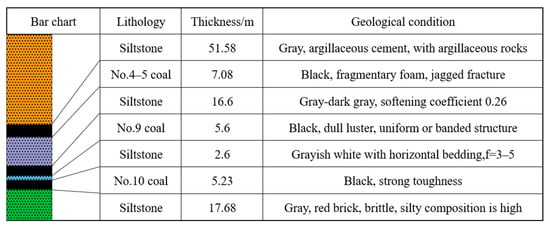
Figure 1.
Comprehensive column chart of strata.
Among these, the coal seams studied in descending order from shallow to deep are No. 4, No. 5, and No. 9. As shown in Figure 2, the No. 4 and No. 5 coal seams have a high degree of coalescence, with an average coal thickness of 7.08 m, a simple structure and a relatively stable coal seam. The roof lithology is dominated by siltstone, and the floor is siltstone. The No. 9 coal seam is 16.6 m away from the No. 5 coal seam and its thickness is 5.6 m, the floor and roof are siltstone, the thickness of the whole coal is stable and belongs to a stable coal bed group, and there is no single super-thick hard sandstone layer in the upper part. However, due to the existence of several groups of mixed sandstone groups, the suspended roof may be easily formed in the mining process of the panel, resulting in stress concentration, elastic accumulation and abnormal pressure behavior. The 11903 panel of the buried depth of the No. 9 coal seam is 342~378 m. The inclined length is 130 m and the top is the residual coal pillar of the No. 4–5 coal seam with a width of 18 m. The pressure frame accident that occurred in this panel occurred during mining.
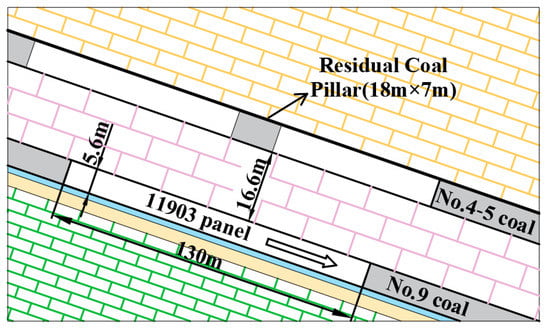
Figure 2.
Location diagram of coal seam and panel.
When mining in the lower panel, stress redistribution of the overlying strata will be caused. When the mining reaches the stress concentration area below the coal pillar, the influence of this disturbance will destroy the coal pillar and lead to the instability of the overlying strata, resulting in a more extensive range of overlying rock movement.
As shown in Figure 3, the basic roof above the coal pillar breaks to form a hinged structure composed of three key blocks, A, B, and C, which support the weight of the upper strata and maintains overall stability when it is in equilibrium. The stability of key block B needs to meet specific mechanical conditions: when the friction force between key blocks A and B is greater than the shear force between them, the slip motion will not occur between them and key block B will not lose stability; and when the positive pressure between key blocks A and B is greater than the compressive strength of the key block, rotational instability will also not occur between them. When the lower coal seam is mined, the subsidence of the coal pillar increases the force between key blocks A and B, and when key block B meets the mechanical conditions of instability, rotary subsidence movement occurs and drives the movement and collapse of the upper strata. The stress is then transmitted downwards through the coal pillar, resulting in deformation of the support frame and other disasters in the lower panel.
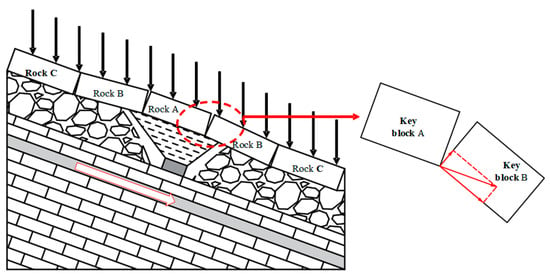
Figure 3.
Schematic diagram of the coal and rock structure in gently inclined multi-seam mining.
3. Establishment of Numerical Model
Numerical simulation software is a common research tool in the field of mining engineering and geotechnical engineering. However, in the face of different problems, it is necessary to select the appropriate simulation software according to the specific application scenarios and the mechanical principles of the software, as this will have an important impact on the accuracy of the final calculation results [22,23]. Continuous media mechanics analysis software such as FLAC is more suitable for simulating stress changes and deformation in the mining process, while discrete element software is more suitable for studying damage and fracture simulation on an engineering scale [24].
UDEC is a two-dimensional numerical simulation software based on the discrete element method of discontinuous media. It regards the object as a collection of discontinuous blocks and discontinuous contact surfaces between the blocks. The macroscopic deformation and strength behavior of the numerical model depends on the mechanical parameters of the block and the contact surface. Because the rock material has the characteristics of joints and cracks, UDEC is ideal for simulating and analyzing the discontinuous fractures of the surrounding rock and the overlying rock movement caused by underground mining [25,26,27]. Some scholars have also used it to simulate the movement of coal pillars and overlying rock [28,29,30,31]. To study the failure and instability characteristics of coal and rock during mining under the residual coal pillar, this paper ultimately uses UDEC as the simulation software.
In this simulation, the elastic constitutive model is used for blocks and the coulomb slip model is used for contacts. As shown in Figure 4, the deformation and mechanical behaviors of the numerical model depend on the micromechanical parameters of the trigon blocks. In the normal and tangential direction of the contact surface, when the normal force or tangent direction does not exceed the strength, the mechanical response behavior is controlled by the normal stiffness and tangent stiffness; when the normal force or tangential force exceeds the strength, the contact surface demonstrates tensile failure or shear failure.
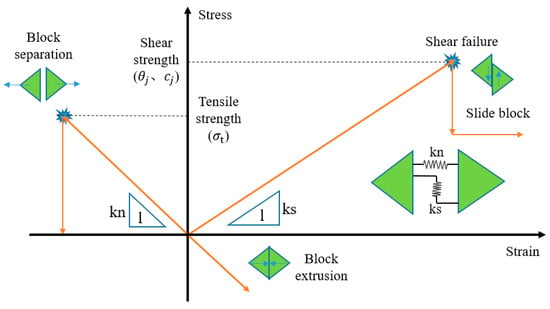
Figure 4.
Structural model of the block contact surface.
Based on the geological conditions of the 11903 panel of the Baoping coal mine in Xinjiang, a numerical calculation model of gently inclined multi-coal seam mining was established, as shown in Figure 5.
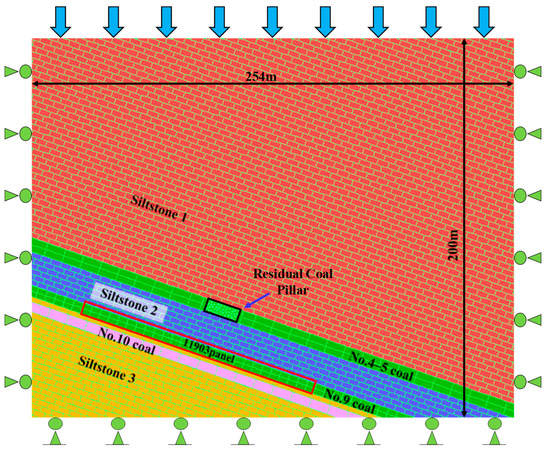
Figure 5.
Numerical model diagram of UDEC.
The size of the 2D model is 254 m wide × 200 m high, and the total number of blocks is 3074. For monitoring the damage and crack propagation of coal pillars, a total of 128 triangular blocks with dimensions of 18 m × 7.08 m were generated in the coal pillar area. Additionally, rectangular blocks and grid divisions were used in siltstone 1 and siltstone 2 to better study the movement of rock layers, stress distribution, and crack development. The maximum edge length of the triangular block 1.5 m and the size of the rectangular block is 6 m × 3 m; The upper coal seam was divided into rectangular blocks of 10 m × 3.04 m, except for the coal pillar area, while the lower coal seam was divided into rectangular blocks of 5 m × 2.8 m, in order to make the coal seam excavation more convenient. The left and right boundaries of the model are set with horizontal displacement constraints, while the bottom boundary is set with vertical displacement constraints. At the top of the model, stress boundaries are set, and a vertically downward load of 6.25 MPa is applied to simulate the pressure of overlying strata.
After setting the model’s initial conditions, the model is first run to the equilibrium state to simulate the original stress state. Then, the formation of the 4–5 coal seam goaf is simulated by deleting blocks, which form the residual coal pillars. After reaching stability, the excavation of the ninth coal panel 11,903 is simulated. This process is divided into multiple steps, from the high side to the low side. At the initial stage, the mining step distance was 10 m. After advancing 30 m, the mining face approached the area of residual coal pillars. To better observe changes in the coal column and its surrounding rock formations, the distance advanced by each step is reduced to 5 m. The model is run to the equilibrium state after each excavation step.
Due to the significant differences between the mechanical parameters, such as Young’s modulus and compressive strength obtained from mechanical tests and the actual rock mass, considering the influence of the discontinuity of the actual rock mass on the rock mechanics parameters, RQD values for each rock layer are used as a measure. Based on the research results of Zhang L et al. [32]. and Singh M et al. [33], Formula (1)
where Em and Er are the elastic model of the rock mass and intact rock, respectively, and RQD is a quality index for rocks, was used to establish the relationship between RQD and the ratio of Em/Er, and Formula (2)
where σcm and σc are the compressive strength of intact rock and rock mass, respectively, and q is taken as 0.63, was used to calculate the compressive strength of the rock mass, where the tensile strength σtm of the coal–rock mass was taken as 0.1 times the compressive strength σcm. Based on the RQD data measured on-site, the estimated mechanical parameters are shown in Table 1.

Table 1.
Physical and mechanical property parameters of coal and rock mass.
The block model used in the simulation is an elastic model, and the contact surface uses the Mohr–Coulomb sliding model. After calibrating the macroscopic parameters, it is necessary to calibrate the microscopic parameters of the UDEC model blocks and contacts based on the mechanical parameters in Table 1, rather than directly assigning the obtained rock mass physical parameters.
A series of simulated uniaxial compression tests will be conducted here, as shown in Figure 6. The initial parameters of the block and contact should be assumed, and the peak stress obtained from the compression test will be compared with the compressive strength of the rock mass in Table 1. The micro parameters will be continuously adjusted based on the results until the calculation matches the macroscopic rock parameters, which will be considered the completion of calibration. The results of the verified microscopic parameters from numerical simulations are shown in Table 2.
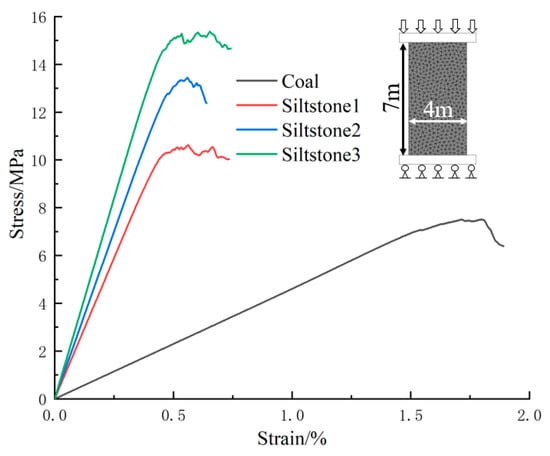
Figure 6.
Simulated uniaxial compressive test and results.

Table 2.
Microscopic parameters of the model after checking.
4. The Analysis of the Instability Process of Coal Rock during Mining under Residual Coal Pillars in a Gently Dipping Seam
It is necessary to analyze the changes in cracks, stress, and displacement during the mining process to understand the mechanism of coal–rock instability during mining under residual coal pillars. According to the sequence of simulated experiments, the upper coal seam panel is first excavated and run to the equilibrium state to form a residual coal pillar. Then the lower coal seam panel is removed from the high side to the low side.
In the early stage of excavation, the development of cracks, stress, and displacement in the coal pillars and surrounding rock mass is relatively small until it approaches the stress concentration zone under the residual coal pillar, where significant changes begin to occur in all indicators. The process continues until the coal pillar area is excavated and the model is re-balanced, with an advancing distance ranging from 50 m to 110 m. The changes in the cracks, stresses, and displacements in the model during this process are shown in Figure 7.
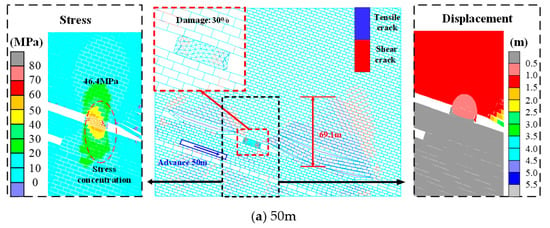
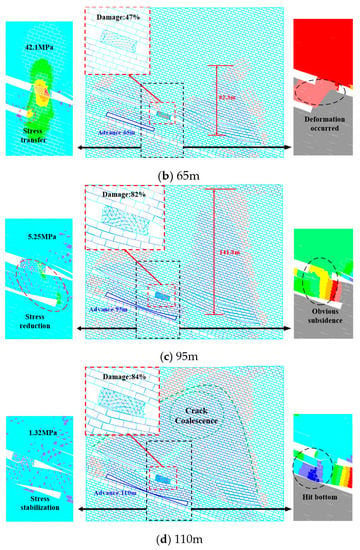
Figure 7.
Model advance phase change diagram.
To understand the stress changes in the lower coal seam during the excavation process, measuring lines were placed in front of the excavation face to record the vertical stresses in the coal mass at different distances. The results are shown in Figure 8.
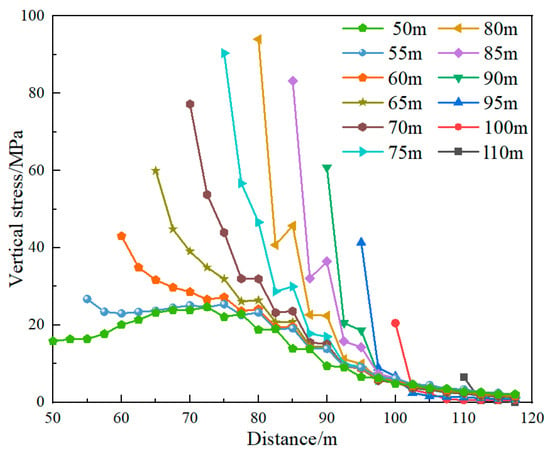
Figure 8.
The vertical stress distribution map in front of the propulsion.
To understand the stress changes and internal crack development of the coal pillars during the excavation process, Fish language was used to monitor the vertical stresses on the coal pillars and the number of different types of cracks. The damage parameter, D, has been proposed, according to Gao [27]:
where NS is the number of shear cracks, Nt is the number of tensile cracks, NC is the total number of joints, N is the total number of cracks, and D is the damage parameter used in this study to characterize the degree of damage to the coal pillars. The monitoring results of stress and damage rate on the coal pillars are shown in Figure 9, corresponding to the spatiotemporal range from 50 m to 110 m.
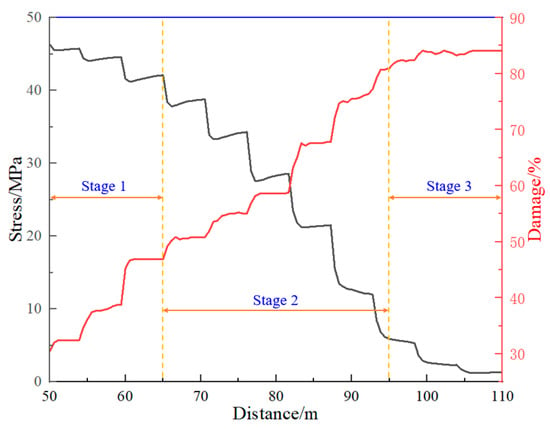
Figure 9.
Coal pillar stress and damage rate change diagram.
At a distance of 50 m, compared with before the excavation, the overall model showed little change in cracks, stress distribution, and displacement. The entire process after that can be divided into three stages: the first stage from 50 to 65 m, the second stage from 65 to 95 m, and the third stage from 95 to 110 m.
In the first stage, as the excavation position gradually approaches the stress radiation area of the coal pillar floor, the displacement of the surrounding rock mass is not significant, and the development of cracks is relatively slow. However, the coal pillar is significantly disturbed, with a damage rate increasing to 46.9%. Shear cracks begin to develop from both sides and gradually cover the entire coal pillar area, while the stress changes inside the coal pillar are relatively small. In addition, the vertical stress in front of the excavation face gradually increases from 15.8 MPa to 59.9 MPa, and the stress gradually concentrates towards the excavation face. At the end of this stage, the interlayer rocks begin to break, and there are signs of linkage between the coal pillar and the interlayer rocks. The failure mode of the coal pillar also switches from shear failure to tensile failure.
During the second stage, as the panel advances through the area under the coal pillar, the period of greatest change in the model occurs. Cracks in the coal pillar and surrounding rock mass rapidly develop, mainly in the form of tensile failure. The stress distribution in the coal pillar and surrounding rock mass changes dramatically, with the stress in the coal pillar rapidly decreasing to 5.25 MPa and the damage rate increasing significantly to 82.4%. It can be seen that the coal pillar undergoes instability and loses its bearing capacity during this stage. Meanwhile, the vertical stress on the coal ahead of the advancing face initially increases sharply, reaching a peak value of 94.0 MPa when the face advances to 80 m, and then quickly decreases to 41.4 MPa at the end of this stage. The stress concentration zone shifts from the coal pillar to the coal area in front of the advancing face and then gradually decrease. In addition, the boundary coal pillars in the upper coal seam show increased stress. Overall, the interlayer rock mass bends and subsides, and the coal pillar begins to move downward from the left side. The overlying rock mass of the coal pillar also undergoes large-scale movement. The movement process from the interlayer rock mass to the coal pillar and then to the overlying rock mass is relatively fast, which is a warning signal that strong mining pressure will occur in the lower panel.
In the third stage, the advancing face gradually moves away from the area under the coal pillar, and the rate of decrease in stress on the coal pillar slows down and gradually stabilizes. The development of cracks in the coal pillar almost stops, and the damage rate increases slowly. At the end of this stage, the stress and damage rate of the coal pillar is 1.32 MPa and 84.1%, respectively. Meanwhile, the stress in front of the advancing face gradually decreases and becomes stable, ultimately reaching 9.5 MPa. During this stage, the coal pillar and the overlying rock mass continue to subside together with the interlayer rock mass until they completely collapse. Afterward, the range of movement of the overlying rock mass gradually ceases to expand.
During the advancement of the entire panel, as the coal seam below the coal pillar is gradually mined, the intervening rock layers bend and subside under the influence of the concentrated stress transmitted through the coal pillar. The coal pillar also moves downward under the action of overlying strata stress and undergoes failure and instability in this process. The concentrated internal stress transfers downward to the surrounding rock of the panel, while the collapse of the coal pillar and overlying strata occurs, and the scope of collapse gradually expands. The intervening rock layer, coal pillar, and overlying strata move together until the intervening rock layer reaches the bottom. At this time, the stress concentration around the panel gradually decreases, and the range of overlying strata movement no longer expands, eventually reaching a stable state. The simulation results of the movement process in the coal seam have been compared with the findings of other scholars based on laboratory experiments, numerical simulations, and field monitoring data [18,19,20]. This provides evidence supporting the reliability of our simulation.
5. Analysis of Influence Factors of Coal and Rock Instability in Gently Inclined Close-Distance Coal Seam
Based on the research status and the previous study, the width-to-height ratio of the residual coal pillar, the thickness of the interlayer rock mass, and the thickness of the lower coal seam were selected as the research objects. An orthogonal simulation test was designed, in which the residual coal pillar’s width-to-height ratio (w/hm) was set as the variable. In contrast, the thickness of the lower coal seam (hd) and the thickness ratio of the interlayer rock mass to the residual coal pillar floor (hj/w) were used as variables.
In the case of constant coal pillar height and interlayer rock mass thickness, different coal pillar widths and lower coal seam thicknesses were set to control the size of the two variables. Specifically, the coal pillar height was set at 7 m, based on geological conditions, while the width was set at 10 m, 14 m, 18 m, and 22 m. The interlayer rock mass thickness was set at 16.6 m according to the actual field situation, while the lower coal seam thickness was set at 2.4 m, 3.3 m, 4.2 m, and 5.6 m. There are a total of 16 schemes, and the excavation process sequence of the model is consistent for each scheme. Cracks, stress cloud maps, and displacement cloud maps were extracted according to the stages described in the previous section, and the legends used are the same as in the previous section.
Based on the conclusion in the previous section, the end of the second stage (at a distance of 95 m) is the node at which the model enters a stable phase during the excavation process. The coalescence of the cracks on coal pillar overlying rock at the end of the second stage was taken as an indicator to differentiate between the results of each scheme. A coordinate system was established to represent the results, as shown in Figure 10. The red area indicates that the cracks have coalesced, while the green area means that they have not yet coalesced.
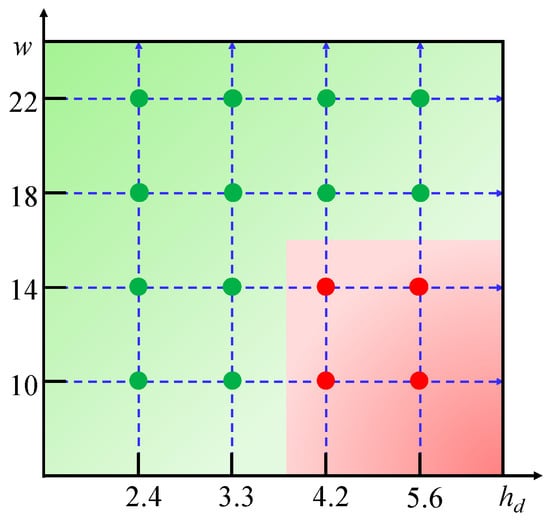
Figure 10.
Illustration of simulation test results.
Based on the distribution of the experimental results, it can be seen that both the thickness of the lower coal seam and the width of the coal pillar significantly impact the degree of coalescence of cracks on both sides. When hd ≤ 3.3 (hj/hd ≥ 5) or w ≥ 18 m (w/hm ≥ 2.57), the cracks on both sides do not coalesce, and when hd ≥ 4.2 m (hj/hd ≤ 4) and w ≤ 14 m (w/hm ≤ 2), the cracks coalesce. In practical scenarios, the ratio of interlayer rock mass thickness to lower coal seam thickness can be determined to consider the width of the upper coal seam coal pillar to ensure safety during the excavation of the lower panel.
To study the mechanism by which the thickness of the lower coal seam affects the model, the results at the end of the second stage (95 m) for different thicknesses of the lower coal seam were selected for the same 14 m width of the coal pillar. A comparison was made between cracks and displacements, as shown in Figure 11.
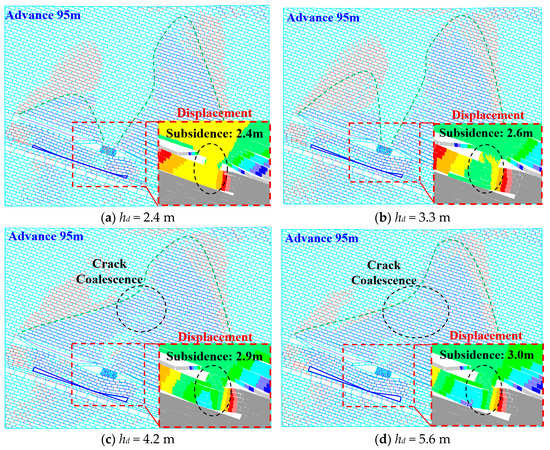
Figure 11.
Simulation test results of different lower coal seam thickness models.
At the end of the second stage, the advancing face has moved away from the position under the right side of the coal pillar. The displacement of coal pillars and their surrounding rocks is directly proportional to the thickness of the lower coal seam. When the thickness of the lower coal seam reaches 4.3 m, the rock layer directly above the coal pillar also shows apparent cracks. Eventually, the cracks on both sides of the goaf will merge. After comparative analysis, the main impact of the thickness of the lower coal seam lies in the displacement of the coal pillar and interlayer rock mass when the area under the coal pillar is excavated and the coal pillar and interlayer rock mass move to the bottom. According to the theory in Section 2, as the coal pillar supports a large range of overlying rock mass above it, the subsidence of the coal pillar will cause the rotation and movement of the upper structure. The more subsidence there is of the coal pillar, the greater the displacement and range of movement of the overlying rock mass above it. When the amount of subsidence reaches a certain level, the cracks on both sides of the coal pillar’s overlying rock mass coalesce into a larger arch-shaped crack zone.
Previous studies have shown the influence of the thickness of the lower coal seam on the movement of the coal and rock when the coal pillar has a specific thickness. Models with different widths of the coal pillar were selected to investigate the mechanism of the residual coal pillar width, with the thickness of the lower coal seam set at 4.2 m and set as the research object. Figure 12 compares the operating results of different models at the end of the second stage (95 m), and the changes in the vertical stresses and damage levels of the coal pillars in the model during the second stage (65–95 m) were monitored using Fish language.
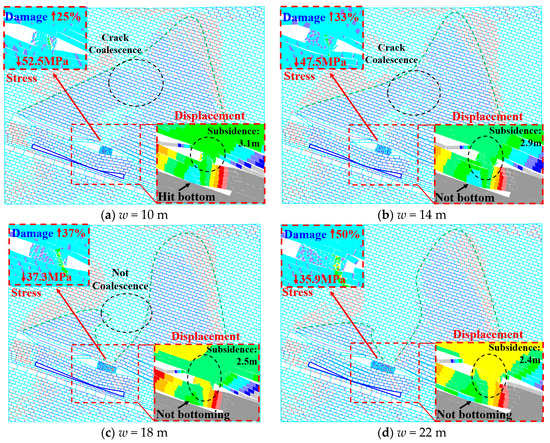
Figure 12.
Simulation test results of residual coal pillar model with different widths.
Compared with the four models in the above figure, the overall degree of development of overlying rock fractures is lower in cases where the coal pillar width is larger than when it is smaller. In addition, the subsidence of the coal pillar and surrounding rocks is always smaller when the coal pillar width is larger. When the coal pillar width is 14 m and 10 m, the overlying rock fractures on both sides of the coal pillar have coalesced. At this point, the damage rate of the coal pillar increases, and the internal stress decreases significantly. Because the wider residual coal pillars are disturbed by the mining below for a longer time, their growth in damage rate is also greater. On the other hand, due to the high degree of stress concentration in coal pillars with smaller widths, their stress drops more under disturbance. At the end of the stage, both the 14 m and 10 m coal pillars have reached the bottom of the interlayer rock mass below them, while the interlayer rock mass under the 18 m and 22 m coal pillars has not yet been reached. This is because the subsidence of the coal pillar is related to the excavation degree of the coal seam below it, and wider coal pillars require a larger range of coal seam excavation for complete subsidence. Therefore, at the same advancing distance, wider coal pillars and their lower interlayer rock mass have a smaller degree of subsidence, and the degree of movement of the overlying rock mass above the coal pillars is also lower.
In summary, the two main factors affecting the instability of coal–rock movement are the thickness of the underlying coal seam and the width of the coal pillar. These factors primarily influence the amount of subsidence in the intervening rock layer and coal pillar. The former controls the maximum subsidence value, while the latter controls the duration of subsidence. Based on the monitoring data of coal pillar subsidence in the model, when the subsidence reaches 2.9 m, the fractured zones of the overlying strata coalesce above the coal pillar, causing a large-scale collapse of the overlying strata and forming a single arch shape.
6. Conclusions
Concerning a gently dipping coal seam group, this paper provides a comprehensive analysis of the process of mining at a close distance under a residual coal pillar from various perspectives using UDEC. Additionally, by conducting orthogonal experiments, it investigates the impact of coal pillar size and lower coal seam thickness on coal–rock instability. The obtained key conclusions are summarized as follows:
- (1)
- An analysis was conducted on the stress conditions of key rock blocks above the residual coal pillar and the overall structure of the coal pillar and its surrounding rock mass. It was concluded that the disturbance caused by the excavation of the lower coal seam resulted in the failure of the residual coal pillar and the instability of the overlying rock structure, ultimately leading to mining pressure accidents in the lower panel.
- (2)
- The mining process beneath residual coal pillars in gently inclined coal seams was simulated using UDEC software. It was found that the movement of coal and rock can be divided into three stages, with the advancing distance of 65 m and 95 m serving as the boundaries. The damage level of the coal pillar mainly changes during the second stage, while it tends to be stable during the first and third stages. The stress of the surrounding rock mass of the coal pillar gradually shifts forward to the lower panel with the failure of the coal pillar and then transfers to the boundary coal pillars. The movement of coal pillars becomes violent as of the second stage, and develops slowly toward stability in the third stage; during this stage, coalescence occurs between the fractures on both sides of the coal pillars, leading to a large-scale collapse of the overlying strata.
- (3)
- An orthogonal simulation experiment was conducted with the width of the residual coal pillar and the thickness of the lower coal seam as variables; the results indicate that when hd ≥ 4.2 m (hj/hd ≤ 4) and w ≤ 14 m (w/hm ≤ 2), the subsidence will reach or exceed 2.9 m, and the fractures in the overlying strata on both sides of the residual coal pillars will coalesce. The thickness of the lower coal seam directly affects the maximum value of the interval rock layer and the coal pillar subsidence. In contrast, the coal pillar’s width directly affects the time of subsidence.
Author Contributions
Conceptualization, C.Z. and J.Z.; methodology, M.C.; software, J.Z.; validation, C.Z., J.Z. and M.C.; formal analysis, J.Z.; investigation, F.B.; resources, C.Z.; data curation, Z.Z.; writing—original draft preparation, J.Z.; writing—review and editing, C.Z.; visualization, F.B.; supervision, M.C.; project administration, Z.Z.; funding acquisition, J.Z. All authors have read and agreed to the published version of the manuscript.
Funding
The research was supported by the National Natural Science Foundation of China (52004145) and the Natural Science Foundation of Shandong Province (ZR2020QE119).
Institutional Review Board Statement
Not applicable.
Informed Consent Statement
Not applicable.
Data Availability Statement
The data used to support the finding of this study are available from the corresponding author upon request.
Acknowledgments
All authors thank the reviewers for their valuable comments.
Conflicts of Interest
The authors declare no conflict of interest.
References
- Ghabraie, B.; Ren, G.; Barbato, J.; Smith, J.V. A predictive methodology for multi-seam mining induced subsidence. Int. J. Rock Mech. Min. Sci. 2017, 93, 280–294. [Google Scholar] [CrossRef]
- Shen, W.; Dou, L.M.; He, H.; Zhu, G.A. Rock burst assessment in multi-seam mining: A case study. Arab. J. Geosci. 2017, 10, 196. [Google Scholar] [CrossRef]
- Suchowerska, A.M.; Merifield, R.S.; Carter, J.P. Vertical stress changes in multi-seam mining under supercritical longwall panels. Int. J. Rock Mech. Min. Sci. 2013, 61, 306–320. [Google Scholar] [CrossRef]
- Iwanec, A.M.S.; Carter, J.P.; Hambleton, J.P. Geomechanics of subsidence above single and multi-seam coal mining. J. Rock Mech. Geotech. Eng. 2016, 8, 304–313. [Google Scholar] [CrossRef]
- Zang, C.W.; Chen, M.; Zhang, G.C.; Wang, K.; Gu, D.D. Research on the failure process and stability control technology in a deep roadway: Numerical simulation and field test. Energy Sci. Eng. 2020, 8, 2297–2310. [Google Scholar] [CrossRef]
- Behrooz, G.; Gang, R.; Smith, J.V. Characterising the multi-seam subsidence due to varying mining configuration, insights from physical modelling. Int. J. Rock Mech. Min. Sci. 2017, 93, 269–279. [Google Scholar] [CrossRef]
- Gao, R.; Yu, B.; Meng, X. Stress distribution and surrounding rock control of mining near to the overlying coal pill-ar in the working face. Int. J. Min. Sci. Technol. 2018, 29, 881–887. [Google Scholar] [CrossRef]
- Yang, W.F.; Sui, W.H.; Xia, X.H. Model test of the overburden deformation and failure law in close distance multi-seam mining. J. Coal Sci. Eng China 2008, 14, 181–185. [Google Scholar] [CrossRef]
- Michael, G.; Christopher, M. Unanticipated multiple seam stresses from pillar systems behaving as pseudo gob–case histories. Int. J. Min. Sci. Technol. 2017, 27, 131–137. [Google Scholar] [CrossRef]
- Zhao, Z.H.; Wang, W.M.; Wang, L.H.; Dai, C.Q. Compression–shear strength criterion of coal–rock combination mod-el considering interface effect. Tunn. Undergr. Space Technol. 2015, 47, 193–199. [Google Scholar] [CrossRef]
- Tan, Y.L.; Guo, W.Y.; Gu, Q.H.; Zhao, T.B.; Yu, F.H.; Hu, S.C.; Yin, Y.C. Research on the Rock burst Tendency and AE Characteristics of Inhomogeneous Coal-Rock Combination Bodies. Shock. Vib. 2016, 2016, 9271434. [Google Scholar] [CrossRef]
- Wu, K.; Shao, Z.S.; Sharifzadeh, M.; Hong, S.Y.; Qin, S. Analytical computation of support characteristic curve for circumferential yielding lining in tunnel design. Rock Mech. Geotech. Eng. 2022, 14, 144–152. [Google Scholar] [CrossRef]
- Liu, J.; Wang, E.Y.; Song, D.Z.; Wang, S.H.; Niu, Y. Effect of rock strength on failure mode and mechanical behavior of composite samples. Arab. J. Geosci. 2015, 8, 4527–4539. [Google Scholar] [CrossRef]
- Wu, H.; Jia, Q.; Wang, W.J.; Zhang, N.; Zhao, Y.M. Experimental test on nonuniform deformation in the tilted strata of a deep coal mine. Sustainability 2021, 13, 13280. [Google Scholar] [CrossRef]
- Li, Z.; Liu, J.C.; Liu, H.X.; Zhao, H.B.; Xu, R.C.; Gurkalo, F. Stress distribution in direct shear loading and its implication for engineering failure analysis. Int. J. Appl. Mech. 2023, 2350036. [Google Scholar] [CrossRef]
- Li, Z.; Liu, J.; Xu, R.; Liu, H.X.; Shi, W.H. Study of grouting effectiveness based on shear strength evaluation with experimental and numerical approaches. Acta Geotech. 2021, 16, 3991–4005. [Google Scholar] [CrossRef]
- Chen, M.; Zhang, Y.; Zang, C.; Zhang, G.; Li, Q.; Jiang, B. Experimental investigation on pressure relief mechanism of specimens with prefabricated reaming boreholes. Rock Mech. Rock Eng. 2023, 56, 2949–2966. [Google Scholar] [CrossRef]
- Ma, J.J.; Chen, J.J.; Chen, W.X.; Huang, L.C. A coupled thermal-elastic-plastic-damage model for concrete subjected t-o dynamic loading. Int. J. Plast. 2022, 153, 103279. [Google Scholar] [CrossRef]
- Gao, R.; Kuang, T.; Lan, Y. The mechanism and control technology of strong strata behavior in extra-thick coal seam mining influenced by overlying coal pillar. Open Geosci. 2019, 11, 452–461. [Google Scholar] [CrossRef]
- Zhang, Z.Z.; Deng, M.; Wang, X.Y.; Yu, W.J.; Zhang, F.; Dao, V.D. Field and numerical investigations on the lower coal seam entry failure analysis under the remnant pillar. Eng. Fail. Anal. 2020, 115, 104638. [Google Scholar] [CrossRef]
- Ju, J.F.; Xu, J.L.; Zhu, W.B. Longwall chock sudden closure incident below coal pillar of adjacent upper mined coal seam under shallow cover in the Shendong coalfield. Int. J. Rock Mech. Min. Sci. 2015, 77, 192–201. [Google Scholar] [CrossRef]
- Manouchehrian, A.; Cai, M. Influence of material heterogeneity on failure intensity in unstable rock failure. Comput. Geotech. 2016, 71, 237–246. [Google Scholar] [CrossRef]
- Chen, M.; Yang, S.Q.; Zhang, Y.C.; Zang, C.W. Analysis of the failure mechanism and support technology for the Dongtan deep coal roadway. Geomech. Eng. 2016, 11, 401–420. [Google Scholar] [CrossRef]
- Lin, Y.X.; Ma, J.J.; Lai, Z.S.; Huang, L.C.; Lei, M.F. A FDEM approach to study mechanical and fracturing responses of geo-materials with high inclusion contents using a novel reconstruction strategy. Eng. Fract. Mech. 2023, 282, 109171. [Google Scholar] [CrossRef]
- Lisjak, A.; Grasselli, G. A review of discrete modeling techniques for fracturing processes in discontinuous rock masses. J. Rock Mech. Geotech. Eng. 2014, 6, 301. [Google Scholar] [CrossRef]
- Su, O.; Akcin, N.A. Numerical simulation of rock cutting using the discrete element method. Int. J. Rock Mech. Min. Sci. 2011, 48, 434–442. [Google Scholar] [CrossRef]
- Ma, J.J.; Guan, J.W.; Duan, J.F.; Huang, L.C.; Liang, Y. Stability analysis on tunnels with karst caves using the distinct lattice spring model. Undergr. Space 2021, 6, 469–481. [Google Scholar] [CrossRef]
- Zhao, Y.; Luo, S.; Wang, Y.; Wang, W.; Zhang, L.; Wan, W. Numerical analysis of karst water inrush and a criterion for establishing the width of water-resistant rock pillars. Mine Water Environ. 2017, 36, 508–519. [Google Scholar] [CrossRef]
- Gao, F.Q.; Stead, D. The application of a modified Voronoi logic to brittle fracture modelling at the laboratory and field scale. Int. J. Rock Mech. Min. Sci. 2014, 68, 1–14. [Google Scholar] [CrossRef]
- Gao, F.Q. Simulation of Failure Mechanisms around Under-Ground Coal Mine Openings Using Discrete Element Modelling. Ph.D. Thesis, Simon Fraster University, Burnaby, BC, Canada, 2013. Available online: https://summit.sfu.ca/item/13680 (accessed on 3 April 2023).
- Wu, W.D.; Bai, J.B.; Wang, X.Y.; Yan, S.; Wu, S.X. Numerical Study of Failure Mechanisms and Control Techniques for a Gob-Side Yield Pillar in the Sijiazhuang Coal Mine, China. Rock Mech. Rock Eng. 2019, 52, 1231–1245. [Google Scholar] [CrossRef]
- Zhang, L.; Einstein, H.H. Using RQD to estimate the deformation modulus of rock masses. Int. J. Rock Mech. Min. Sci. 2004, 41, 337. [Google Scholar] [CrossRef]
- Singh, M.; Seshagiri, R.K. Empirical methods to estimate the strength of jointed rock masses. Eng. Geol. 2005, 77, 127. [Google Scholar] [CrossRef]
Disclaimer/Publisher’s Note: The statements, opinions and data contained in all publications are solely those of the individual author(s) and contributor(s) and not of MDPI and/or the editor(s). MDPI and/or the editor(s) disclaim responsibility for any injury to people or property resulting from any ideas, methods, instructions or products referred to in the content. |
© 2023 by the authors. Licensee MDPI, Basel, Switzerland. This article is an open access article distributed under the terms and conditions of the Creative Commons Attribution (CC BY) license (https://creativecommons.org/licenses/by/4.0/).